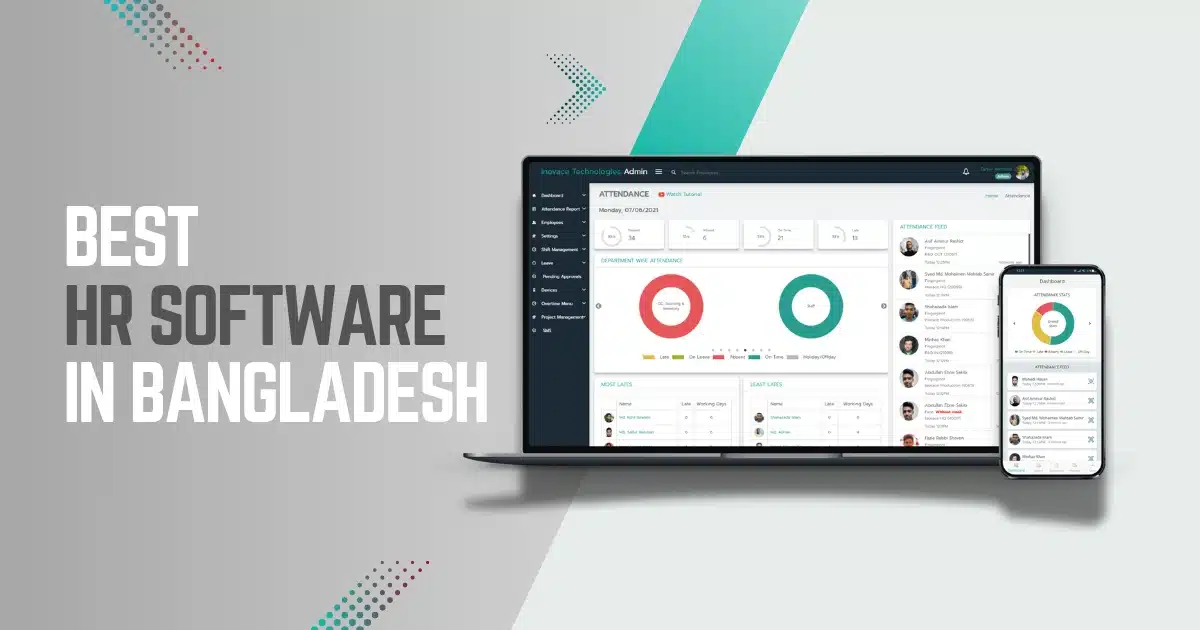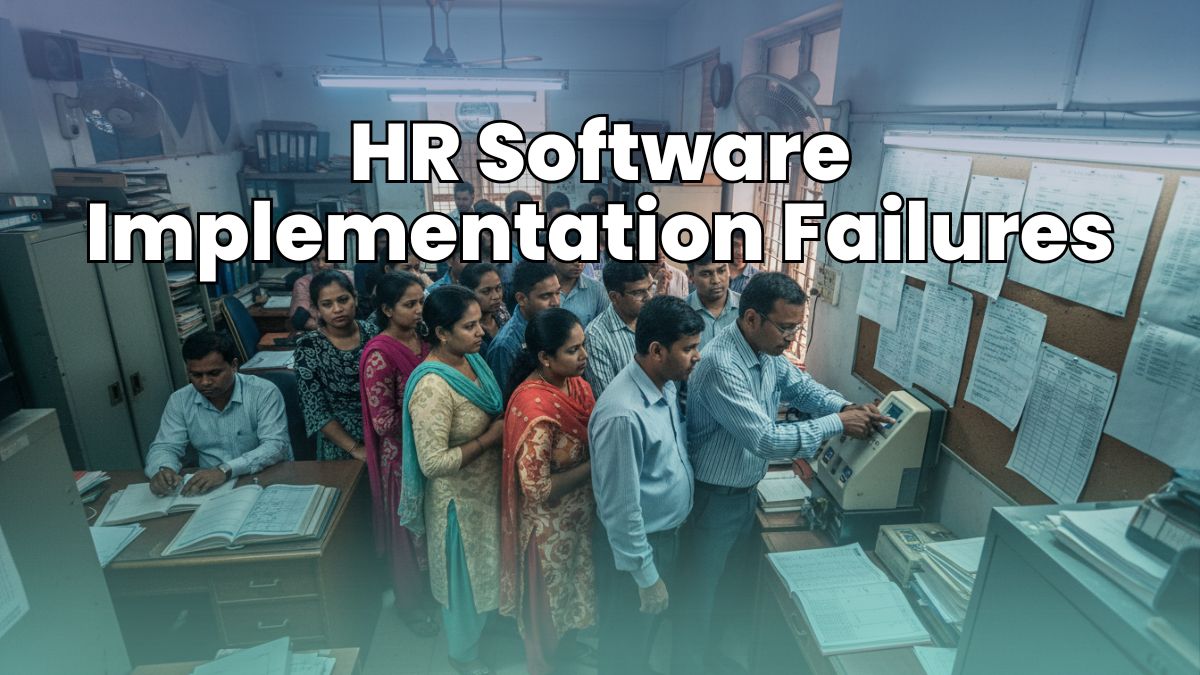Looking for the best HR software in Bangladesh to streamline your team management? After researching the Bangladesh HR software market and comparing top 10 solutions based on features, pricing, and local support, this guide covers everything you need to make the right choice.
Whether you need biometric attendance, local payroll automation, mobile-first access, or compliance management, this comparison covers everything—from features and pricing to real user experiences.
At a Glance: Top 10 HR Software in Bangladesh (2025)
Software | Best For | Highlight Features | Starting Price | Trial Info |
|
Tipsoi |
All-rounder for 🇧🇩 teams | Local payroll, GPS punch, mobile-first cloud HR, biometric + HR system integration | ৳ 1000/month |
Demo on request |
|
PiHR |
SMEs and midsize organizations | Payroll, leave management, built-in reporting |
৳ 2,500/month |
Demo on request |
| Smart HRM | Garments, factories & corporate | Wireless biometric, complex payroll, multi-shift | ৳ 1,200/month | Demo available |
|
PeopleDesk |
Enterprise-grade HR |
Workflow automation, asset mgmt |
Custom |
12-day free trial |
Jibika Plexus | Compliance-focused orgs | Deep compliance tools + customization | MMC ৳ 5,000/month | Demo available |
| GreenHR | Modern cloud-first teams | Paperless, strong mobile app, cloud HRIS | Custom | Free trial |
Rysenova | Cloud-first for 🇧🇩 orgs | Automated payroll, geo-fencing, mobile app, analytics, Bangla UI | ৳ 1,000/month | 7-day free trial |
Accord HRM | Local HR operations & SMEs | Employee management, payroll, attendance tracking, compliance | ৳ 80-100 per employee/month | Free trial available |
|
Zkteco HRM |
Factory & device-heavy orgs |
Biometric + HR system integration; free version with limitations |
Depends on license |
Free version with limits; paid license for advanced features |
Apploye | Remote & hybrid teams | Time tracking, GPS, screenshot monitoring | $2.5/user/month | 10-day trial |
Quick Recommendation:
- Remote teams: Pick Apploye or GreenHR
- Small businesses (10-50 employees): Start with Tipsoi or Rysenova
- Garments/Manufacturing: Choose Smart HRM or ZKTeco
- Enterprise (500+ employees): Go with PeopleDesk or Jibika Plexus
Why Finding the Right HR Software Matters in Bangladesh (My Story)
As an HR manager at a small, ambitious company in Dhaka, I wasn’t prepared for how wild HR management could be. I was buried in leave requests, endless payroll calculations, and daily scrambles to track who was actually on time. Staring at messy Excel sheets in the middle of the night, I kept thinking—there’s got to be a better way.
That’s when my search for the best HR software in Bangladesh truly began.
Why Does HR Software Matter So Much Right Now?
When you’re running a team or helping your company grow, you know that every minute saved from manual administrative tasks is a minute gained for your employees. HR software is more than just a digital register; it’s the difference between chaos and clarity.
In 2025, as so many Bangladeshi businesses go digital, modern HR tools have become almost essential:
- Payroll and compliance rules keep changing and getting more complex
- Teams are working in hybrid or remote ways, sometimes scattered across the country
- Employees expect better self-service and smoother communication (and frankly, I do too)
But with so many choices out there, picking the right HR solution can feel overwhelming. Most lists I found were just sales pitches or skipped over the special needs we have here in Bangladesh.
What Makes an HR Software the ‘Best’ in Bangladesh?
Before I picked any software, I had to ask myself: What does “best HR software” even mean in the context of Bangladesh?
Here’s the checklist I used—and you should too:
✓ Local Payroll & Compliance Support Managing bonuses, taxes (AIT), and government rules in Bangladesh isn’t simple. You need tools that handle local payroll structure and compliance updates.
✓ User-Friendliness for Everyone Software should be intuitive for every user—not just admins. If people can’t use it easily, it simply doesn’t get used.
✓ Bangla & English Language Support Some team members—especially field and factory workers—are more comfortable in Bangla. Having a Bangla-friendly UI helps ensure nothing gets lost in translation.
✓ Mobile Accessibility For field teams and non-desk workers, mobile access with GPS punch-in and real-time updates is essential.
✓ Responsive Customer Support Global tools often have 24-hour delays in replies. But when issues come up around salary or attendance, you need support you can actually talk to—in Bangladesh Standard Time.
✓ Affordable Pricing Find something affordable but complete—without breaking the bank on per-module, per-admin fees.
These were my filters while exploring dozens of options. Let’s dive into the detailed reviews.
Top 10 HR Software in Bangladesh: Detailed Reviews
1. Tipsoi—All-in-One Cloud HR Software, Proudly Made for Bangladesh
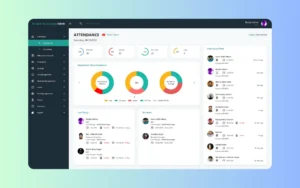
When I first came across Tipsoi, I wasn’t sure what to expect from a locally built HR solution. But using it daily, I started to appreciate just how well it’s tuned for Bangladeshi teams and the kind of real challenges we face from shift changes to managing field staff and keeping communication easy for everyone.
We’re the only HR platform in Bangladesh that makes biometric hardware as well as cloud software tailored for our needs, allowing seamless integration for attendance and access control across busy, multi-site teams.
Why I Picked Tipsoi
Tipsoi clicked for me because it simply makes running HR smoother, no matter what size or shape your team is. It’s not just about ticking technical boxes; it’s about making life easier for real people at work.
What stood out to me:
- Biometric & GPS Attendance:
Our staff could easily check in using biometric devices or their phones, with GPS punch-ins letting me know who’s where—especially important for field or multi-branch teams. - Local Payroll Support:
Payroll calculations, bonuses, and compliance are set up for Bangladeshi rules—so I don’t have to worry about manual adjustments or errors. It’s all handled inside Tipsoi without extra Excel files. - Geofencing & Field Employee Tracking:
Built-in geofencing lets me manage staff who work outside the main office. Field teams can only punch in/out from assigned locations, giving me real-time visibility and peace of mind about staff on the go. - Bangla & English Support:
The interface naturally fits both Bangla and English speakers. Even those less comfortable with tech picked it up quickly. - Mobile-First Experience:
With strong Android and iOS apps, every team member—whether in the office or on the move—could manage their own attendance, shifts, and leave requests. - Modern HR Modules:
Tipsoi brings together document management, visitor and parking control, smart team announcements, leave workflows, and analytics. Everything’s just a couple of clicks away. - 24/7 Local Support:
Every time I needed guidance or had a question, their support team responded fast, understood my problem, and got things fixed without extra jargon.
Tipsoi Standout Features & Integrations
Features:
- Intuitive HR database for onboarding, offboarding, and daily workflows
- Biometric and GPS-enabled attendance tracking for flexible workforce setups
- Self-service for leave, shift swaps, and announcements (in both Bangla/English)
- Document and visitor management modules, keeping operations streamlined
- HR analytics to spot trends and improve team wellbeing
Integrations:
- Compatible with widely used biometric devices in Bangladesh
- Seamless with Tipsoi’s own biometric hardware
- API support for easy plug-in with accounting or business tools
Trial, Pricing & Who It’s For
Trial: 7-day free trial—so your whole team can give it a spin before deciding
Pricing: Starts at ৳ 1000/month (makes sense for SMEs; scales up neatly for larger orgs)
Best for :
- SMEs and midsize Bangladeshi businesses
- Teams with a mix of office, field, and shift workers
- Leaders who want less time on admin, more on people
Pros & Cons
Pros:
- Designed for Bangladesh’s language/culture from the ground up
- Clean, friendly interface that works for anyone—no matter their digital skills
- Mobile and web access, equally strong
- Truly helpful, local support whenever you need it
Cons:
- Some advanced analytics may require extra setup for large Projects.
- Pricing for multi-branch, very large organizations needs consultation
2. PiHR — Reliable HR Software for Growing Bangladeshi Businesses
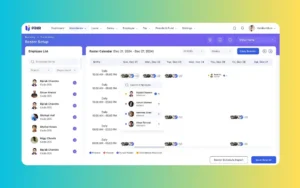
There’s a reason PiHR kept popping up when I asked fellow business owners about their HR tools: it’s practical, well-established in Bangladesh, and designed to make the busy work of HR disappear—even for teams juggling fast growth and constant change.
Why I Picked PiHR
PiHR won me over with its clear layout and focus on what actually matters day-to-day. I found it especially useful for handling HR at scale, where you have dozens (or hundreds) of people clocking in, needing leave approvals, or just wanting to get updates without chasing HR staff.
Some of my favourite things about PiHR:
- User-Friendly Attendance & Shift Management:
Staff can clock in via biometric or mobile app, but the backend tracking and roster management are really what make life easier—especially during peak business periods. - Effortless Leave Requests & Approvals:
Employees submit requests from their phones, managers approve with a tap, and HR never has to chase paperwork. - Simple, Helpful Dashboards:
I appreciated how PiHR translates your mess of attendance and leave data into at-a-glance visuals—no data science degree required. - Localized Features:
PiHR is well-tuned for Bangladeshi businesses, offering Bangla notifications, local public holiday calendars, and shift logic that actually matches the ground reality. - Responsive Team:
Their support folks got back quickly and were able to walk me through the solution.
PiHR Standout Features & Integrations
Features:
- HR information system (HRIS) for employee data and life cycle
- Biometric and mobile attendance tracking
- Leave management and approval workflows
- Shift scheduling and roster control
- Payroll-ready data exports
- Built-in analytics for workforce trends
Integrations:
- Compatible with popular biometric hardware in Bangladesh
- Can export data into accounting and payroll formats for smooth handoff to finance teams
Trial, Pricing & Who It’s For
- Trial: Demo available by request—so you can see it in action before you buy
- Pricing: Starts at ৳ 2,500/month (great entry point for small and midsize teams)
Best for:
- SMEs and fast-growing businesses wanting solid, no-fuss HR automation
- Companies ready to move beyond Excel or manual punch cards
- Managers who want better oversight with less manual admin
Pros & Cons
Pros:
- Reliable biometric and mobile attendance
- Bangla-enabled notifications and local support
- Dashboards make workforce data easy to understand
- Clear, affordable entry pricing for growing companies
Cons:
- Deep customizations or advanced modules may need a larger package or integration
- Features like performance evaluation or advanced analytics may not be included in base pricing and could require an upgrade.
3. Smart HRM — Trusted HR Solution for Garments, Factories & Corporate

When I started asking around in the garments and manufacturing sector, one name kept coming up: Smart HRM. Built by Smart Software Ltd with over a decade of experience serving Bangladeshi businesses.
Why I Picked Smart HRM
Smart HRM focuses on what matters most for Bangladesh’s largest industries: reliability, simplicity, and handling complex workforce scenarios with hundreds or thousands of employees across shifts and factory floors.
What I Liked Most
Built for Bangladesh’s Backbone Industries: Specifically designed for garments, factories, and large corporate offices. It understands shift patterns, overtime rules, and payroll complexity.
Wireless Biometric Cloud Attendance: Standalone biometric devices send attendance data directly to the cloud via GPRS or Wi-Fi. No messy cables, no server headaches.
Comprehensive Payroll Management: Handles piece-rate payments, production bonuses, overtime, festival allowances, and all local compliance requirements.
Easy for Non-Tech Teams: Factory supervisors and HR staff—who aren’t necessarily tech-savvy—find it simple to use.
Modular & Scalable: Whether you’re a 50-person office or a 5,000-worker factory, Smart HRM scales with you.
Smart HRM Standout Features & Integrations
Features:
- Complete employee database with lifecycle management
- Wireless biometric attendance with cloud sync
- Advanced payroll for garments/manufacturing
- Multi-shift scheduling and roster management
- Leave and absence tracking
- Comprehensive workforce analytics
- Multi-location support
Integrations:
- Compatible with Smart Biometric devices
- Works with standard fingerprint/RFID systems
- Export for accounting/ERP systems
- API for custom integrations
Trial, Pricing & Who It’s For
Trial: Demo available on request
Pricing: Custom pricing based on size and modules
Best for:
- Garment factories and the RMG sector
- Manufacturing with shift-based workforces
- Large corporate offices (100+ employees)
- Multi-location operations
Pros & Cons
Pros:
- 10+ years proven track record
- Wireless biometric eliminates infrastructure hassles
- Handles complex garments/manufacturing payroll
- Scalable from small to enterprise
- Strong local compliance support
Cons:
- Interface is functional but not ultra-modern
- Pricing requires consultation
- May be feature-heavy for simple offices
4. PeopleDesk — Flexible HR for Teams With Complicated Setups
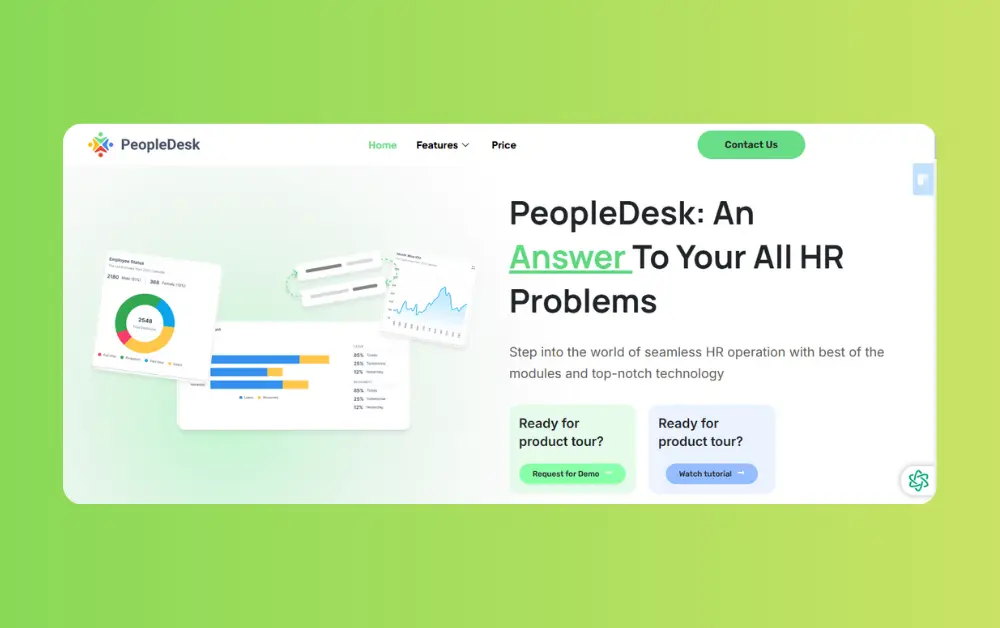
I heard about PeopleDesk from a friend managing HR in a big export business. I’ll be honest: for a long time, I thought enterprise HR tools were just overloaded with menus and never quite fit our local style. But after digging in, I realized this platform is actually built to help manage the chaos that comes with large teams, department layers, and endless approval chains—without losing your sanity.
Why I Picked PeopleDesk
If you’ve ever struggled to keep up with onboarding checklists, asset tracking, and those mysterious approval emails that just never arrive, PeopleDesk has your back. What won me over was how easy it made it to automate the annoying “paper chases” of big teams. Instead of chasing signatures or remembering which form needs which manager’s approval, I could create custom workflows once, and then just let the system handle the reminders.
The asset management feature is way more useful than I expected—think tracking who has which work laptop, when ID cards are due for renewal, and what’s missing after a round of new hires. I love that you don’t need to be an IT whiz to set things up—HR teams can build their own flows and tweak things as needed.
What I Liked Most
- Workflow Automation:
No more manual chasing for approvals—just set a rule, and PeopleDesk sends the right nudges at the right time. - Department Flexibility:
I could manage separate teams, assign different holidays, and create approval chains based on actual company structure—so much easier for big or multi-branch outfits. - Engagement & Surveys:
You can run in-house polls and feedback loops easily. These little tools make it simpler to know how the team’s actually feeling, not just what’s on paper. - Centralized Docs & Asset Tracking:
All HR docs (joining letters, policies, exit processes, even laptops or uniforms) in one place. If you’ve lost things before, you know how useful this is.
PeopleDesk Standout Features & Integrations
Features:
- Custom Workflow Builder
- Asset Lifecycle Management
- In-App Surveys & Feedback Collection
- Role-Based Permissions
- Audit Trail & Compliance Logging
Integrations:
- Works with popular biometric devices to sync attendance and shift data.
- Offers API access to connect with payroll or other business systems.
Trial, Pricing & Who It’s For
Trial: You get 12 days free to play around with full features, which gave me enough time to test with both HR and regular staff.
Pricing: Custom—depends on company size and setup. Worth asking for a tailored package.
Best For:
- Medium to large companies with multiple departments or complex approval layers
- Businesses needing asset tracking alongside HR management (like laptops, uniforms, etc.)
- HR teams looking to bring structure and automation to messy, manual processes
Pros & Cons
Pros:
- Automates painful, repetitive admin steps
- Asset & document management is genuinely helpful
- Highly customizable workflows for even messy org charts
- Free trial lets you test before you commit
Cons:
- Might feel hefty if your needs are super simple
- Some workflow customizations take a little trial and error
5. Jibika Plexus — HR Software Built for Compliance-Driven Organizations
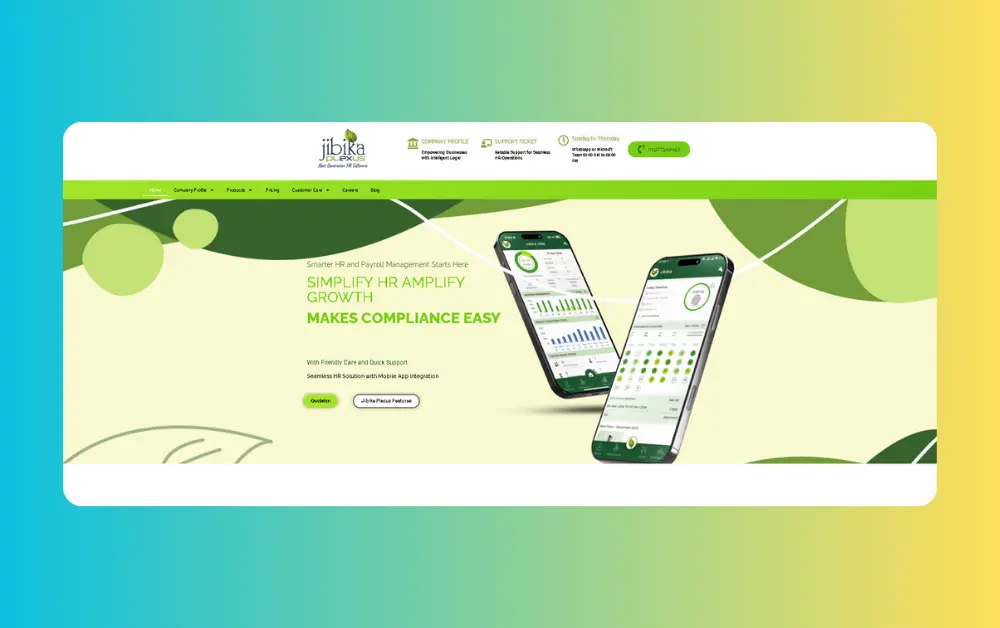
You’ll be able to take control if you work in a highly regulated industry or have complex shift structures, strict approval hierarchies, or multiple business units with Jibka Plexus. With its administrative depth and customization, it instantly caught my attention when I was looking for HR tools with a strong local focus.
Why I Picked Jibika Plexus
What makes Jibika Plexus stand out is its attention to policy enforcement, fine-grained user roles, and localization. Where many tools offer simplicity upfront (and less control behind the scenes), Jibika Plexus offers the opposite: full flexibility to define your team’s own workflows, shift policies, and even compliance rules.
I appreciated that it didn’t try too hard to be “trendy”—instead, it focuses on being reliable, detailed, and policy-aware.
What I Liked Most
- Local Compliance Peace of Mind: Payroll and tax rules in Bangladesh can change fast, but Jibika keeps everything patched and up-to-date behind the scenes—no late-night calculator panics.
- Customizable Workflows: I could set up leave types, roster shifts, and approval policies to match whatever our company needed—super flexible, whether you’re a small startup or a big group.
- Bangladeshi Language Support: HR notices, contracts, and portal access all in Bangla if you want. My team found it much easier to get onboarded and actually use the tools.
Jibika Plexus Standout Features & Integrations
Features:
- Full employee lifecycle management
- Multi-layered shift and roster planning
- Leave tracking with pre-configured local holidays
- Advanced role-based access control and division-level security
- Audit trails and admin logs for compliance tracking
- Integrated task lists, joining/exit formalities, HR notices, and more
Integrations:
- Compatible with biometric attendance systems
- Allows data export for payroll processing and compliance audits
- API integration available for connecting to accounting or ERP tools
Trial, Pricing & Who It’s For
- Trial: Trial/Demo available upon request—especially helpful to understand its setup and navigation
- Pricing: Starts at MMC ৳ 5,000/month, with options to add modules and expand per organizational size
Best for:
- Medium to large companies needing highly flexible HR policy enforcement
- Organizations with layered departments, compliance audits, or detailed shift operations
- HR admins who want full control over how each part of the system works (down to notifications and user access)
Pros & Cons
Pros:
- Built with Bangladeshi compliance in mind from the ground up
- Extremely customizable shift, access, and role management
- Ideal for large teams with multi-level admin structures
- Stable and scalable for long-term use
Cons:
- Interface may feel heavy for smaller teams or non-HR departments
- Setup and onboarding might require some training or assistance
- Features beyond core HR often require custom configuration
6. GreenHR — Modern, Paperless Cloud HR for Forward-Thinking Companies

In a world where everyone talks about “going green” and “digital transformation,” I was curious to see if there was an HR platform that actually lived up to those buzzwords. That’s when I discovered GreenHR.
Why I Picked GreenHR
GreenHR represents the newer generation of HR software in Bangladesh. While many established players started as on-premise systems, GreenHR was designed from day one to be fully cloud-based, mobile-friendly, and genuinely paperless.
What I Liked Most
True Cloud-First Architecture: Everything lives in the cloud—no servers to maintain, no software to install. Access your HR data securely from anywhere.
Paperless HR Operations: From offer letters to payslips to leave applications—everything is digital. Faster approvals, better record-keeping.
Mobile App That Actually Works: The mobile app isn’t just a limited version—it’s full-featured. Clock in/out, apply for leave, check payslips, all on the go.
Modern User Experience: Clean dashboards, logical workflows, helpful guides. Onboarding doesn’t feel like a chore.
Affordable for Growing Companies: Enterprise-grade features without the enterprise price tag.
GreenHR Standout Features & Integrations
Features:
- Cloud-based HRIS with zero infrastructure
- Paperless document management
- Full-featured mobile app (iOS/Android)
- Attendance with biometric and GPS
- Leave management with automated approvals
- Payroll with built-in compliance
- Employee self-service portal
- Real-time analytics and reporting
Integrations:
- Compatible with biometric devices
- Connects with accounting software
- API access for custom integrations
- Seamless cross-device experience
Trial, Pricing & Who It’s For
Trial: Free trial available
Pricing: Custom pricing (typically affordable for SMEs)
Best for:
- SMEs and startups want modern HR
- Remote or hybrid teams
- Sustainability-focused companies
- Teams valuing user experience
Pros & Cons
Pros:
- Genuinely modern, cloud-first platform
- Strong mobile app experience
- Paperless reduces costs and environmental impact
- No infrastructure or IT maintenance
- User-friendly interface
- Regular updates and features
Cons:
- Newer player vs. decade-old brands
- May need customization for large enterprises
- Still building brand recognition
7. Rysenova — Modern, Mobile-First HR Platform for Bangladeshi Businesses
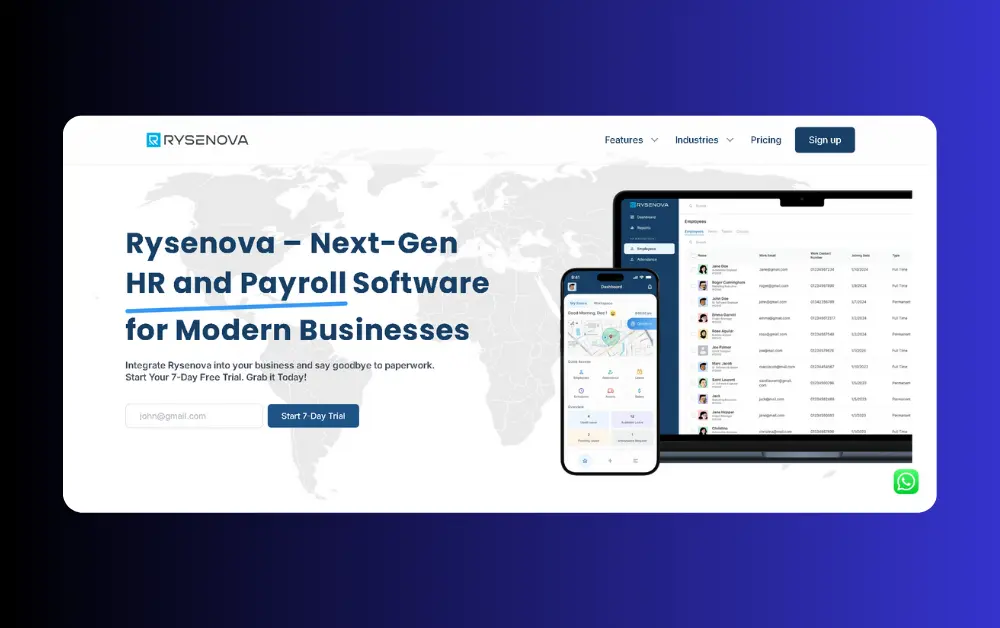
When I tested Rysenova, the first thing I noticed was how user-friendly it was—even for teammates who don’t live in spreadsheets or dashboards all day. It blends together the must-haves of modern HR—like attendance, leave, and payroll readiness—with a clean mobile-first experience and strong support for local compliance.
Why I Picked Rysenova
Rysenova really impressed me with its geo-fencing-enabled attendance, real-time analytics, and smart HR tools (like onboarding checklists and employee self-service) that didn’t feel overwhelming. If you’re running a growing business in Bangladesh and want a solution that doesn’t require hours of training or huge rollout plans, Rysenova is a great fit. Plus, the support team was helpful and responsive when I reached out with questions.
Here’s where it stood out for me:
- Smart Attendance with Location Awareness:
Staff can clock in via mobile, bio-device, or even based on defined geo-locations, ensuring accurate and tamper-proof records. - Designed for Bangladesh, Not Just Adapted:
Everything from the payroll structure to holiday calendars and language options feels like it was actually built for us—not custom-patched later. - Quick Onboarding with Lightweight Setup:
I was able to get most features up and running during the trial, without needing IT support or a week of handholding.
Rysenova Standout Features & Integrations
Features:
- Geo-fenced and biometric attendance tracking
- Employee onboarding and document management
- Leave requests, shift logs & absence tracking
- Core HR database with custom fields and access control
- Mobile app support (Android/iOS)
- Data analytics dashboards with overtime, leave, and churn insights
- Bangla/English UI for broader team adoption
Integrations:
- Compatible with biometric devices widely used across Bangladesh
- API available for payroll handoff, accounting sync, and system extensions
Trial, Pricing & Who It’s For
Trial: Free 7-day trial with full feature access
Pricing: Starts at ৳ 1,000/month for small teams; modular as you scale
Best for:
- Small to medium-sized businesses looking for easy rollout
- Companies with both office and non-desk staff
- Business owners who want visibility without complexity
Pros & Cons
Pros:
- Very friendly for first-time HR software users
- Strong mobile app with secure GPS + biometrics
- Bangla interface helps improve staff adoption
- Responsive customer support based in Bangladesh
Cons:
- Some modules may require tailoring for large-enterprise workflows
- Less built-in workflow logic compared to deep enterprise platforms
8. Accord HRM — All-in-One Cloud HR Software, Designed for Bangladesh
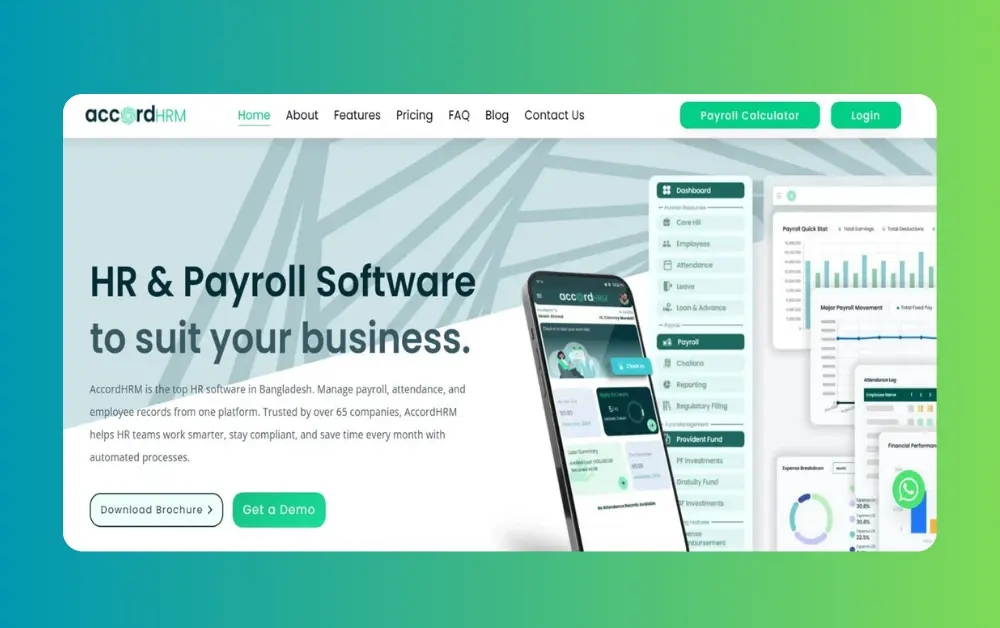
When I first explored Accord HRM, my main hope was to untangle the usual HR chaos—attendance, payroll, leave requests—all the nitty-gritty, without endless paperwork or chasing scattered records. What I found is that Accord HRM brings everything under one roof, tuned for Bangladeshi companies facing real, everyday challenges like compliance, staff loans, and proper fund management.
We’re looking at a platform that isn’t just built for HR teams—it’s meant for every manager and employee across the business, with clear workflows, flexible modules, and support that speaks our language.
Why I Picked Accord HRM
I chose Accord HRM because it bundles together so many of the features I wished for—no messy integrations, no separate tools for payroll or attendance, and no more HR confusion. The experience feels organized and straightforward, and the dashboard puts everything I care about just one or two clicks away.
What I Liked Most
- All-in-One Simplicity: From recruitment to exit clearance, every HR task lives in one tidy system. No more juggling spreadsheets, emails, or missed follow-ups—it all just flows.
- Automated Statutory Reports: PF, gratuity, and bonus statements are ready in clicks, already formatted for local regulations. Saved me hours (and a few grey hairs) during annual audits.
- Employee Self-Service: I liked that leave applications, payslips, and personal info updates could be handled by staff themselves—cutting down on paperwork and endless “status” calls to HR.
Accord HRM Standout Features & Integrations
Features:
- Automated payroll processing tailored to Bangladeshi regulations
- Compliance reporting and statutory audit support
- Provident fund calculation and management
- Gratuity fund tracking and disbursement automation
- Centralized core HR database for employee lifecycle management
- Comprehensive employee data and document management
- Flexible leave and attendance tracking, including geofencing and biometric integration
- Loans and advances management linked with payroll processing
Integrations:
- Compatible with popular biometric and attendance devices for seamless punch data.
- Data export/import for payroll and accounting.
- API access for connecting with other business systems, if needed.
Trial, Pricing & Who It’s For
- Trial: Demo available by request—explore full features before subscription.
- Pricing: Starts at ৳ 80-100 per employee/month with flexible plans for any business size.
Best for:
- SMEs and mid-sized companies that want a single, compliant HR and payroll platform.
- Teams with desk, shift, or field workers needing unified attendance and work tracking.
- Business owners and HR leads looking to simplify HR, keep compliance in check, and scale confidently.
Pros & Cons
Pros:
- Covers the full spectrum of HR, payroll, compliance, and fund management under one roof.
- Bangla and English interface makes adoption easy for all staff.
- Cloud and mobile access—no software installation headaches.
- Responsive local support for fast troubleshooting.
Cons:
- Customizations and advanced analytics for complex setups may require extra support from Accord HRM’s team.
- Minimum starting fee is ৳80-100 per employee/month, which could be high for micro-startups.
9. ZKTeco HRM — Hardware-Integrated HR for Factory & On-Site Teams

ZKTeco HRM was a tool I looked into when I was considering biometric hardware for punching in and out at multiple locations. A name that just keeps coming up—especially in manufacturing, logistics, and factories—is ZKTeco if you’re looking for a solution that works well with access control and attendance.
Why I Picked ZKTeco HRM
ZKTeco stood out to me as a hardware-first platform that’s ideal for environments where you’re managing high foot traffic, strict punch-in requirements, or need to link attendance directly with door access or shift validation.
It’s not just an attendance tracker—but a solution that works side-by-side with biometric hardware (both ZKTeco-made and device-compatible). While it’s not as broad in full-suite HR as others in this list, it excels in its niche.
However, I do recommend checking feature availability—and local licensing—carefully, as some versions have limitations based on the devices or packages you use.
What I Liked Most
- Seamless Biometric Integration: Punching in with a fingerprint or face means attendance disputes are practically eliminated. It just syncs so you always know who’s actually there, without chasing anyone for “corrections.”
- Real-Time Reporting: I loved seeing live dashboards for attendance, overtime, late arrivals, and even device health. No more messy, end-of-month surprises just up-to-the-minute clarity you can act on.
ZKTeco HRM Standout Features & Integrations
Features:
- Robust biometric attendance & time tracking
- Device-level data syncing and offline capture
- Shift scheduling, absence tracking & overtime logs
- High compatibility with ZKTeco devices
- Simple reporting module with real-time insights
Integrations:
- Seamless with ZKTeco’s own biometric hardware
- Integration available with attendance APIs and formats for payroll export
- Adapter tools available for connecting to HR/payroll systems
Trial, Pricing & Who It’s For
Trial: ZKTeco offers a free version of the software (often bundled with devices),
but it usually comes with limitations on:
- Number of users
- Devices
- Access to premium modules
For full functionality, a paid license or subscription is often required.
Pricing: Depends on the number of users, devices, and software tier—best to check with your local ZKTeco distributor for accurate and up-to-date licensing.
Best for:
- Manufacturing hubs, factories, and offices with physical punch-in systems
- Companies that already use ZKTeco biometric hardware or plan to invest in it
- Admins who need strict attendance logging linked to work hours, shifts, or gate controls
Pros & Cons
Pros:
- Strong hardware-software integration
- Great for high-volume, time-critical attendance
- Free version available for small teams/hardware bundles
- Built for shift-based industries and physical-site teams
Cons:
- Limited HR functions beyond attendance unless heavily customized
- Advanced features often require paid licensing or setup support
- Less ideal for re
- mote teams or purely cloud-first operations
10. Apploye — Time Tracking & Remote Team Management

As remote and hybrid work became more common in Bangladesh, I needed a tool that could track distributed teams effectively. Apploye emerged as a strong contender for businesses managing remote workers, freelancers, or field teams.
Why I Picked Apploye
Apploye isn’t your traditional HR system—it’s laser-focused on time tracking, productivity monitoring, and remote team management. If your biggest challenge is knowing what your distributed team is working on, Apploye provides the visibility you need.
What I Liked Most
GPS Location Tracking: Perfect for field sales, delivery teams, or remote workers. You can see where team members clock in from and set geofencing boundaries.
Automatic Time Tracking: Employees can track time automatically or manually. It integrates with apps they’re already using to capture work hours accurately.
Screenshot Monitoring (Optional): For remote teams, you can enable periodic screenshots to verify work activity—useful for client billing or accountability.
Detailed Productivity Reports: See which apps and websites team members use, time spent on projects, and productivity patterns.
Simple Payroll Integration: Export timesheet data directly to payroll systems or accounting software.
Apploye Standout Features & Integrations
Features:
- Automatic and manual time tracking
- GPS tracking and geofencing
- Optional screenshot monitoring
- App and website usage tracking
- Project and task time allocation
- Detailed productivity analytics
- Timesheet approvals
- Payroll-ready reports
Integrations:
- Integrates with popular project management tools
- Export to QuickBooks, Xero, and other accounting software
- API available for custom integrations
- Mobile apps for Android and iOS
Trial, Pricing & Who It’s For
Trial: 10-day free trial
Pricing: Starts at $2.5/user/month
Best for:
- Remote and hybrid teams
- Field sales and service teams
- Agencies billing clients by the hour
- Companies needing productivity monitoring
- Freelancer and contractor management
Pros & Cons
Pros:
- Excellent for distributed team visibility
- GPS tracking great for field teams
- Affordable pricing for what it offers
- Easy setup and user adoption
- Strong mobile app support
- Detailed productivity insights
Cons:
- Not a full-featured HRIS (focused on time tracking)
- Screenshot monitoring may feel invasive to some
- Pricing in USD (not BDT)
- Less suited for traditional office-only environments
How to Choose the Best HR Software for Your Bangladesh Business
After reviewing all these options, you might be wondering: “Which one is actually right for ME?”
Here’s my framework for making the decision:
Step 1: Define Your Core Needs
Ask yourself:
What’s my biggest HR headache right now?
How many employees do I have (and plan to have in 2 years)?
What’s my budget realistically?
Do I have field/remote workers or just office staff?
What’s my team’s tech comfort level?
Step 2: Match Software to Your Business Type
Small Startups (10-50 employees): → Choose: Tipsoi, Rysenova, or GreenHR
Why: Simple, affordable, easy to adopt
Priority: User-friendliness over complexity
Garments/Manufacturing (100+ workers): → Choose: Smart HRM or ZKTeco HRM
Why: Built for shift work, production, compliance
Priority: Biometric integration, complex payroll
Growing SMEs (50-200 employees): → Choose: PiHR, Accord HRM, or Tipsoi
Why: Good balance of features and cost
Priority: Scalability, local support
Enterprise/Corporate (500+ employees): → Choose: PeopleDesk, Jibika Plexus
Why: Handles complex workflows, multiple departments
Priority: Customization, compliance depth
Remote/Hybrid Teams: → Choose: Apploye, GreenHR, or Rysenova
Why: Strong mobile apps, GPS tracking
Priority: Remote accessibility, time tracking
Step 3: Test Before You Commit
ALWAYS take the free trial. Here’s what to test:
✓ Day 1-2: Can HR set it up easily? ✓ Day 3-4: Can regular employees use it without help? ✓ Day 5-6: Does support respond quickly? ✓ Day 7: Does it solve your actual problem?
Step 4: Calculate True Cost
Don’t just look at the starting price. Consider:
Per-user fees as you grow
Add-on module costs
Implementation/training fees
Hardware costs (biometric devices)
Annual increases
Pro tip: A ৳500/month solution that needs ৳50,000 in hardware isn’t cheaper than a ৳2,000/month all-inclusive one.
Step 5: Check Local Support Quality
This is HUGE in Bangladesh. Before buying:
Send a test support query
Check response time
Verify if they understand local compliance
Ask if support is in Bangla or English
Final Thoughts — Finding Your Perfect HR Software Match
If there’s one thing I’ve learned while testing and comparing all these tools, it’s this: The “best HR software” isn’t the one with the most features—it’s the one that actually works for you.
Some businesses need strict biometric control. Others need mobile flexibility or deep compliance features. And some, like mine, just want one platform where things don’t break and people actually use it without constantly asking for help.
My Personal Recommendation?
If you want a solution that can handle multiple scenarios—whether you’re a small startup, a factory, a fast-growing team, or a business with tough compliance needs—Tipsoi is your best bet. It’s built to flex for different company sizes and work styles, adapts well to Bangladesh’s regulations, and combines attendance, workflow, and admin control in a single platform.
But here’s the truth: every company is different.
So here’s what I’d suggest:
✓ Take a free trial (don’t skip this!) ✓ Let your team try it, too—not just HR ✓ Ask support questions early, see how fast they answer ✓ Don’t pay for extra dashboards you’ll never use
I hope this breakdown saved you hours of research, and maybe even helped you dodge a few mistakes I made early on.
Thanks for reading—and best of luck finding a tool your whole team actually enjoys using!
Frequently Asked Questions About HR Software in Bangladesh
What is the best HR software in Bangladesh?
The best HR software depends on your organization’s size, needs, and priorities. Among top choices, Tipsoi stands out for its all-in-one simplicity, strong local support, and ability to handle everything from biometric attendance to compliance for Bangladeshi businesses.
Other strong contenders include:
PiHR for growing SMEs
Smart HRM for garments and manufacturing
PeopleDesk for enterprises
GreenHR for modern, cloud-first companies
How much does HR software cost in Bangladesh?
Costs vary based on users, modules, and support:
Tipsoi: Starts at ৳1000/month
PiHR: Starts at ৳2,500/month
Accord HRM: Around ৳80-100/user/month
Jibika Plexus: From MMC ৳5,000/month
Rysenova: Starts at ৳1,000/month
Apploye: $2.5/user/month (~৳300)
Custom solutions like PeopleDesk, Smart HRM, and GreenHR require quotes.
Always ask for custom pricing—many providers offer discounts for larger teams.
Which HR software is best for recruitment?
If recruitment is your top priority, look for solutions with built-in applicant tracking systems (ATS), candidate pipelines, and onboarding automation. PeopleDesk and some international HRMs integrated locally cater well to recruitment management. Read feature lists or ask vendors about dedicated hiring modules.
Can I get a free trial of any of these software?
Yes! Most offer free trials:
Tipsoi: 7-day free trial
PeopleDesk: 12-day free trial
Rysenova: 7-day free trial
Apploye: 10-day free trial
GreenHR: Free trial available
ZKTeco HRM: Free basic version (limited features)
Others like PiHR, Smart HRM, Jibika Plexus offer demos on request.
What are the benefits of using cloud-based HR software?
Cloud-based HR software, such as Tipsoi and Workday, allows businesses to access data from anywhere, ensures data security, and simplifies collaboration across teams.
Is there any HR software that supports Bangla language?
Yes, many local software such as Tipsoi, PiHR, Jibika Plexus, and Rysenova support Bangla UI, notifications, and reports. This ensures even field and factory staff can use the platform comfortably.
Can HR software integrate with other business systems?
Most modern HR software provides integration features:
Many support API connections to accounting, payroll, and ERP systems.
Tipsoi, PiHR, and Rysenova are all compatible with popular biometric hardware and can export data for accounting/payroll purposes.
Always check with providers if you need integrations for specific tools.
Which HR software offers mobile app functionality?
Nearly all leading Bangladeshi HR platforms have mobile apps for iOS and Android. Tipsoi, Rysenova, PiHR, Apploye (strong for location-based features), and ZKTeco HRM offer user-friendly mobile experiences so your team can check in, make requests, and stay updated on the go.
How secure are cloud-based HR solutions?
Well-built cloud HR solutions prioritize security through:
✓ Encrypted data storage and transfer (SSL/TLS) ✓ Regular automated backups ✓ Multi-factor authentication ✓ Role-based access control ✓ Bangladesh-based data centers (some providers) ✓ Compliance with data protection standards
Always ask providers about:
Where data is stored
Backup frequency
Security certifications
Access logging and audit trails
What features should SMEs prioritize when choosing HR software?
For small and medium businesses in Bangladesh, prioritize:
✓ Intuitive, user-friendly dashboard ✓ Bangla/English language support ✓ Mobile accessibility ✓ Biometric/GPS attendance ✓ Leave and shift management ✓ Document management ✓ Responsive local customer support ✓ Affordable, transparent pricing ✓ Scalability (can it grow with you?)
How do I choose the right HR software for my business?
Make a checklist of your core needs (attendance, leave, payroll, compliance, etc.)
Test-drive a few providers with a free trial
Include input from both employees and admins
Assess support responsiveness and software updates
Consider future scalability (can it grow with your business?)
Prioritize platforms that offer local adaptation and support
What is the future of HR software in Bangladesh?
Bangladesh’s HR tech is rapidly evolving with more automation, analytics, and integration with biometric devices. Expect to see smarter self-service, AI-driven analytics, and even deeper local compliance features. Local providers will likely focus on industry-specific needs, multilingual support, and solutions suitable for both desk and non-desk staff.
Can I customize my HR software to meet specific needs?
Yes—most leading solutions (like Tipsoi, Jibika Plexus, PeopleDesk, and Rysenova) allow customization of modules, workflows, user roles, and reports. For unique business processes, ask vendors about custom development or API integration.
How does payroll software in Bangladesh work?
Modern payroll modules calculate basic salaries, overtime, bonuses, advances, taxes (including AIT), and legal compliance (like festival bonuses) based on Bangladeshi regulations. Payslips can be auto-generated and emailed. These systems also connect attendance records directly to payroll calculations for accuracy and efficiency.
Is there any free HR software available in Bangladesh?
Some HRM vendors (like ZKTeco HRM) offer a free basic version for small teams, but these often have limitations on users, devices, or features. For full-featured, scalable software, expect paid plans with trial periods. Always compare free and paid options to ensure you’re not missing essential features
Which HR software is best for garments and manufacturing in Bangladesh?
For garments and manufacturing, Smart HRM is the industry leader. It’s specifically designed for:
Complex shift scheduling
Piece-rate and production bonus calculations
Wireless biometric attendance
Multi-location factory management
Is there any HR software that supports Bangla language?
Yes! Many local solutions support Bangla:
Tipsoi – Full Bangla/English UI
PiHR – Bangla notifications and interface
Smart HRM – Bangla support
Jibika Plexus – Bangla UI option
Rysenova – Bangla/English interface
This is crucial for field workers, factory staff, and non-desk employees.
Which HR software offers mobile app functionality?
Nearly all modern HR platforms have mobile apps:
Tipsoi – Strong Android/iOS apps
Rysenova – Mobile-first design
GreenHR – Full-featured mobile app
Apploye – Excellent mobile time tracking
PiHR – Mobile attendance and leave
Accord HRM – Mobile access available
For field teams and remote workers, mobile functionality is essential.
Can HR software integrate with biometric devices?
Yes! Most Bangladeshi HR software integrates with biometric devices:
Tipsoi – Own hardware + third-party devices
Smart HRM – Wireless biometric integration
ZKTeco HRM – Native ZKTeco hardware support
PiHR – Popular biometric brands
PeopleDesk – Device compatibility
Accord HRM – Biometric integration
Check compatibility with your existing hardware before purchasing.
What’s the difference between cloud-based and on-premise HR software?
Cloud-Based (Recommended for most): ✓ Access from anywhere ✓ No server maintenance ✓ Automatic updates ✓ Lower upfront cost ✓ Better for remote teams ✗ Requires internet
On-Premise: ✓ Complete data control ✓ Works offline ✓ One-time cost (sometimes) ✗ Requires IT infrastructure ✗ Manual updates needed ✗ Higher initial investment
In 2025, cloud-based is the standard for flexibility and cost-effectiveness.
How long does it take to implement HR software?
Implementation time varies by complexity:
Simple cloud solutions (Tipsoi, Rysenova, GreenHR): 1-3 days
Mid-sized implementations (PiHR, Accord HRM): 1-2 weeks
Enterprise solutions (PeopleDesk, Jibika Plexus): 2-4 weeks
Custom configurations (Smart HRM for large factories): 4-8 weeks
Factors affecting timeline:
Company size
Data migration needs
Hardware installation
Customization requirements
Training sessions
Can I customize my HR software to meet specific needs?
Yes! Most leading solutions allow customization:
High Customization:
Jibika Plexus – Highly customizable workflows
PeopleDesk – Custom workflow builder
Smart HRM – Tailored for specific industries
Moderate Customization:
Tipsoi – Configurable modules
PiHR – Adjustable settings
Accord HRM – Flexible configuration
Limited Customization:
Apploye – Focused feature set
ZKTeco HRM – Hardware-dependent options
For unique business processes, ask vendors about custom development or API integration.
Is there any free HR software available in Bangladesh?
Free options are limited:
ZKTeco HRM – Free basic version (limitations on users, devices, features)
Some providers – Free tier for very small teams (usually 5-10 employees)
Reality check: Free versions typically lack:
Full features
Customer support
Scalability
Compliance updates
Recommendation: Invest in a paid solution. Even ৳500-1,000/month is worth it for reliability and support. Take advantage of free trials to test fully-featured versions before committing.
How does payroll software work in Bangladesh?
Modern payroll modules:
✓ Calculate basic salary, overtime, bonuses ✓ Handle advances and loans ✓ Apply taxes (AIT) automatically ✓ Process festival bonuses (Eid, etc.) ✓ Generate payslips automatically ✓ Export for bank transfers ✓ Maintain compliance with labor laws
Best payroll features in:
Smart HRM – Complex manufacturing payroll
Jibika Plexus – Compliance-focused
Accord HRM – Complete payroll automation
Wrapping Up
Choosing the right HR software in Bangladesh is about finding the fit that works for your people—not just a checklist of features. Prioritize user-friendliness, solid customer support, and a platform that understands our local context. Don’t hesitate to take advantage of free trials and involve your team in the decision. The right HR tool should make work life smoother for everyone—from the office to the field. Good luck finding the perfect solution for your team!
Discover more articles:
Cloud HR vs On-Premise Total Cost Over 5 Years: Ultimate Comparison
What Every Business Can Learn from Walmart’s HR Cloud Transformation Journey

